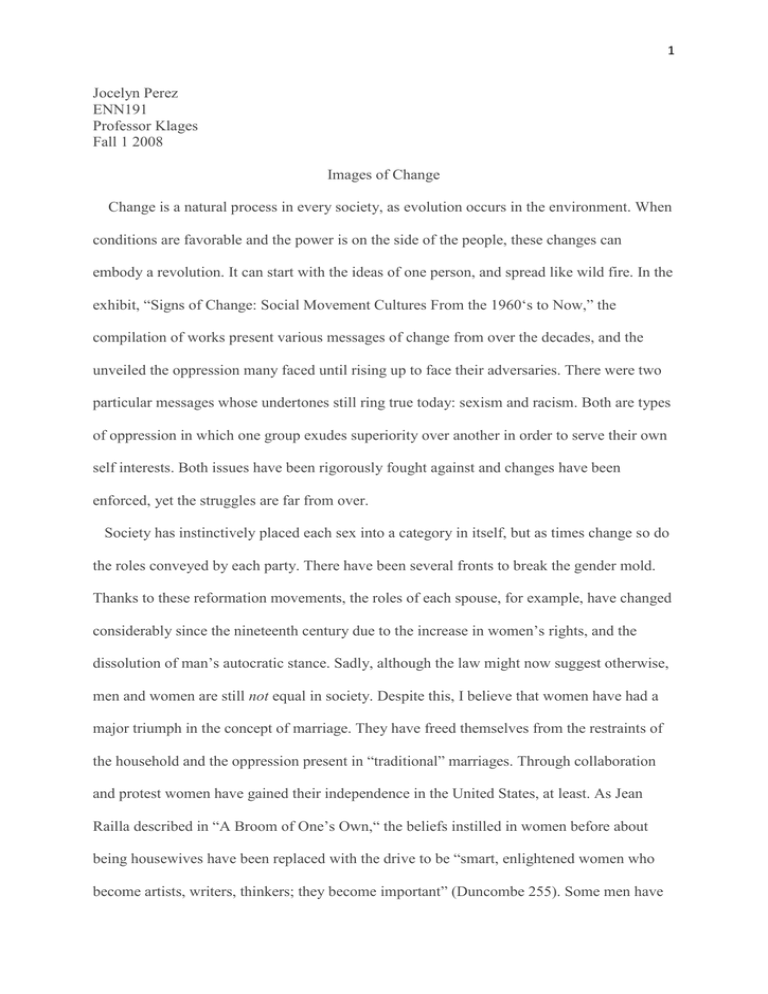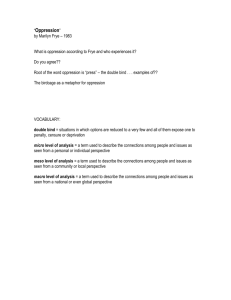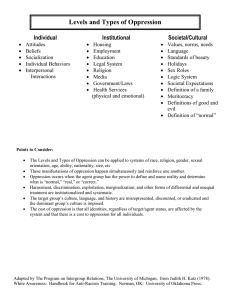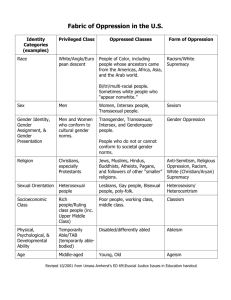Jocelyn Perez ENN191 Professor Klages Fall 1 2008
advertisement

1 Jocelyn Perez ENN191 Professor Klages Fall 1 2008 Images of Change Change is a natural process in every society, as evolution occurs in the environment. When conditions are favorable and the power is on the side of the people, these changes can embody a revolution. It can start with the ideas of one person, and spread like wild fire. In the exhibit, “Signs of Change: Social Movement Cultures From the 1960‘s to Now,” the compilation of works present various messages of change from over the decades, and the unveiled the oppression many faced until rising up to face their adversaries. There were two particular messages whose undertones still ring true today: sexism and racism. Both are types of oppression in which one group exudes superiority over another in order to serve their own self interests. Both issues have been rigorously fought against and changes have been enforced, yet the struggles are far from over. Society has instinctively placed each sex into a category in itself, but as times change so do the roles conveyed by each party. There have been several fronts to break the gender mold. Thanks to these reformation movements, the roles of each spouse, for example, have changed considerably since the nineteenth century due to the increase in women’s rights, and the dissolution of man’s autocratic stance. Sadly, although the law might now suggest otherwise, men and women are still not equal in society. Despite this, I believe that women have had a major triumph in the concept of marriage. They have freed themselves from the restraints of the household and the oppression present in “traditional” marriages. Through collaboration and protest women have gained their independence in the United States, at least. As Jean Railla described in “A Broom of One’s Own,“ the beliefs instilled in women before about being housewives have been replaced with the drive to be “smart, enlightened women who become artists, writers, thinkers; they become important” (Duncombe 255). Some men have 2 thus accepted a more apparent role in their duties as husband and father. This effort to break away is well presented in a poster from 1974, which depicts a woman’s outstretched arm, money in hand, breaking the pile of dishes beneath her. She is obviously lashing out against her title as homemaker, and her household responsibilities. The red coloring of the poster seems to illustrate the urgency for addressing the issue, as does the bright yellow surrounding the woman’s hand. It calls attention to the main priority and becomes the focal point of the piece. The bold lettered words, “Troppo Lavoro Gratis! Salario Al Lavoro Domestico,” call for wages for this hard labor and advertise for International Woman’s Day. This day was to be a collective outcry against male dominated societies, and meant to prioritize women’s rights and independence. In the 1970’s women were still considered fragile beings that’s sole purpose was to bare children and maintain the family home. Many wanted to be compensated for fulfilling the duties expected of them, and others wanted to break away and become another source of income for their families. Then, those who had recently begun to hold positions outside the home asked for equal wages and opportunities for promotion. The Woman’s Day efforts shed light on these restraints and needs, and joined women together at a global scale. The ultimate goal would be to achieve equality among both sexes, and reimbursement for years of free maid service that went unappreciated. During my time at the exhibit, I realized that racism was also a prominent message staring us down from the walls. It is an unfortunate truth driven by ignorance and a false sense of superiority. Although we would like to think that we have come to be colorblind, we are proven wrong by daily acts of hate. However, we have come a long way in the United States. 3 We no longer have segregated schools or water fountains labeled “white” and “colored” that build walls between humanity and encourage prejudice. This was only achieved through the combined efforts of community leaders and the angry voices they tried to comfort. A great example of this sense of initiative is demonstrated in the Greensboro Sit In’s, in which African American college students joined together by sitting at a restaurant counter to break the color barrier present at the establishment. A message calling for an end to separation is boldly illustrated by a poster from 1985 urging for the termination of apartheid in South Africa. The rosey background color, and red color of the African continent in the center, blended to make a very forward statement about the need to address the issue. The color red may also be symbolic of the bloodshed generations have endured because of this division between peoples. An African man seems to emerge from the Southern region of the continent as if trying to climb out of the image. This portrayal may signify the struggle of the natives and their need to break away from the oppression. The words, “End Apartheid. South Africa Must Be Free. Divest Now,” simply outlines the desires of the people and their sense of immediacy. This immediacy was shared by those who hoped to help the victims by holding concerts to raise funds and provide resources. The music at these concerts was meant to spread awareness and shed light on the concerns of the people. One song, “Sun City”, voices these concerns by stating, “We’re rappers and rockers; United and strong. We’re here to talk about South Africa; We don’t like what’s goin’ on” (Reed, 156). The South African people were being kept down by the white population, dehumanized and ordered to carry around documents of identification everywhere they went. These struggles continues well through the eighties, until the early nineties when Nelson Mandela became South Africa’s first black 4 president and made it his life’s purpose to break down these barriers. The “Signs of Change” exhibit showed how imagery and protest brought attention and support to both of these efforts. It was the power of the collective that proved most effective in both cases and now we inch closer to an era free of oppression. These issues unified people who were being discriminated against and empowered them to rise up against their superiors to better their situations. It is through these stands against political and social oppression that change could be ultimately achieved. 5 Works Cited Duncombe, Stephen. Cultural Resistance Reader. New York: Verso, 2002 Greensoro Sit In’s: Launch of a Civil Rights Movement. (15 Nov 2008) <http://www.sitins.com/index.shtml> “Human Rights: Historical Images of Apartheid in South Africa.” United Nations. (14 Nov 2008) http://www.un.org/av/photo/subjects/apartheid.htm Reed, T.V. The Art of Protest. Minnesota: University of Minnesota Press, 2005


